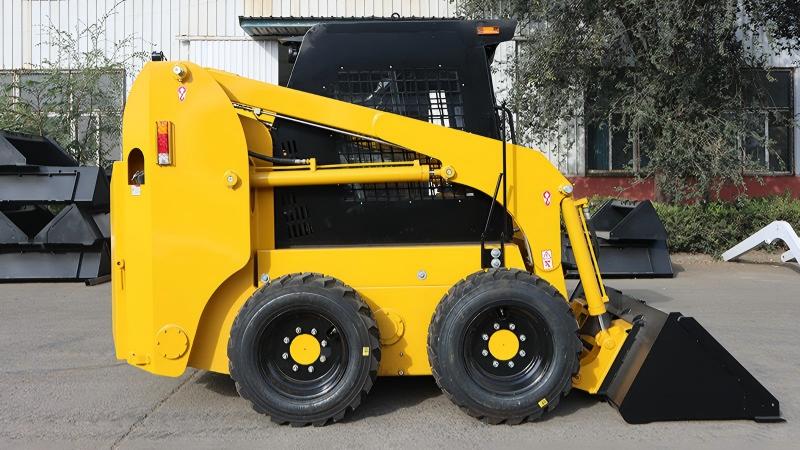The question of the maximum lifting capacity for a standard skid steer loader does not have a single, simple answer, as "standard" is a term that encompasses a range of machine sizes and configurations. However, by examining industry norms and the pivotal concept of the Rated Operating Capacity (ROC), we can establish a clear understanding of what a typical machine can achieve. The ROC is the industry-wide benchmark, defined as 50% of the machine's tipping load measured at a specific height and with the load center at a defined distance from the pivot points. For a standard mid-sized skid steer loader, which is often the workhorse on construction sites, farms, and landscaping projects, this ROC typically falls within a range of 1,500 to 2,200 pounds (approximately 680 to 1,000 kilograms). This rating is not an arbitrary figure; it is a critical safety threshold established by manufacturers and regulatory bodies like the International Organization for Standardization (ISO) to ensure stable and safe operation under typical working conditions. It represents the maximum weight the machine can lift to its full height without risking a forward or lateral tip-over, thereby protecting the operator, the machine, and the surrounding work environment. Understanding that this capacity is a product of rigorous engineering and safety calculations is the first step in appreciating the machine's capabilities and limitations, moving beyond a mere number to a comprehension of its designed operational envelope.
Delving deeper, the actual lifting performance of a skid steer is influenced by a complex interplay of physics, hydraulics, and machine geometry. The fundamental principle governing its capacity is stability, which is directly challenged every time the loader arms are raised and a load is extended forward. The tipping load, the point at which the machine's rear wheels or tracks begin to lift off the ground, is the raw physical limit from which the ROC is derived. This value is profoundly affected by the machine's weight distribution, counterweight design, wheelbase, and the position of the load itself. For instance, a load carried closer to the machine's chassis will exert less forward leverage, allowing for a heavier lift compared to the same load carried at the far reach of the arms. This is why the ROC is defined at a specific load center distance, ensuring a consistent measurement standard across the industry. Furthermore, the hydraulic system's power, including pump flow rate and cylinder bore size, determines the force available to lift the load, while the structural strength of the loader arms and linkage defines the ultimate mechanical limit. Therefore, the published ROC is a conservative, real-world benchmark that accounts for these dynamic forces, ensuring that even when operating on slight inclines or uneven terrain, the machine retains a sufficient margin of safety to prevent catastrophic instability.
Beyond the core specifications of a standard model, it is crucial to recognize that the stated lifting capacity is not a static number applicable to all scenarios. The choice of attachment plays a monumental role in the machine's effective lifting capability. A standard bucket, for example, positions the load relatively close to the machine's pivot points. However, when using a pallet fork, a grapple, or a boom extension, the load center is effectively moved forward, increasing the leverage and thus reducing the safe operating weight. This is a critical consideration for operators; lifting a 2,000-pound pallet with forks requires a machine with a ROC significantly higher than 2,000 pounds to compensate for the increased load moment. Additionally, the machine's configuration, such as whether it is equipped with standard or high-flow hydraulics, can influence auxiliary power but does not directly alter the structural ROC. The condition of the tires or tracks, and even the fuel level, can minutely affect the machine's center of gravity and, consequently, its stability. This underscores the necessity for operators to not only know their machine's ROC but also to understand how their specific work tools and job site conditions dynamically alter the practical, on-the-ground lifting capacity, demanding constant vigilance and judgment.
Ultimately, the responsibility for safe operation rests on the operator's understanding and adherence to the machine's limits, which are clearly documented in the operator's manual and on the load chart typically located within the cab. While a standard skid steer loader might have a Rated Operating Capacity of, for example, 1,750 pounds, this is the maximum safe capacity under ideal, controlled test conditions. Exceeding this capacity, even momentarily, can lead to a dangerous tip-over incident, potentially causing severe injury, fatal crushing, or significant property damage. Modern skid steers are often equipped with built-in load management systems that can warn the operator or automatically restrict lift functions if an overload is detected, but these are aids, not replacements for operator competence. The true "maximum" capacity, therefore, is not a number to be tested, but the ROC value to be respected. For tasks requiring greater lifting power, the industry offers larger, more robust models, including vertical lift path skid steers and compact track loaders, which can feature ROCs exceeding 3,000 pounds. Thus, selecting the right machine for the job and operating it within its certified limits is the definitive practice for achieving both maximum productivity and unwavering safety on any project.
Post time:Nov.18.2025



